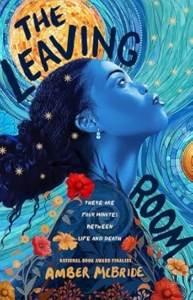The Leaving Room
Amber McBride
Feiwel & Friends
Published October 14, 2025
Amazon | Bookshop | Goodreads
About The Leaving Room
Gospel is the Keeper of the Leaving Room—a place all young people must phase through when they die. The young are never ready to leave; they need a moment to remember and a Keeper to help their wispy souls along.
Gospel assumes that there are countless other Leaving Rooms because many children pass, but she suspects they are not like her Leaving Room which is small (like a walk in closet)with shelves full of tiny jars that hold the memories of those who have gone.
When a random door opens and a Keeper named Melody arrives, their souls become entangled. Gospel seriousness melts and Melody’s fear of connection fades, but still—are Keepers allowed to fall in love? Now they must find a way out of the Leaving Room and be unafraid of their love. They must claw their way back to their bodies because there is so much more life to explore—together.
My Review
I think it’s really cool that this story was inspired by a real experience that her dad had. It’s hard to say more without spoiling the plot, but I liked that she pulled something from her family history for the story. The author’s real family recipes also appear throughout the book as the main character makes desserts and drinks for the people who come to her Leaving Room.
Like some of Amber McBride’s other work, this story explores the space between life and death, and the power of human connections. It looks at how we cherish memories and one another.
In some ways, I think this was the most straightforward storytelling that I’ve ever read in a book from this author. I liked the story a lot, and I didn’t mind the straightforward feel to it.
I felt like I knew Gospel right away. The story is broken into short scenes written in verse. We meet several people who come through Gospel’s room. Eventually Gospel discovers the connection between the stories and realizes she must make a critical choice. The whole story takes place over the course of four minutes. It’s a quick read that had me putting pieces together along the way and finally reveals itself at the very end.
If you’ve read Amber McBride’s books before, I feel like you’ll already know what to expect from this one. If you like ethereal novels in verse that explore spiritual spaces, put this one on your reading list!
Content Notes
Recommended for Ages 12 up.
Profanity/Crude Language Content
None.
Romance/Sexual Content
Kissing.
Spiritual Content
Gospel and Melodee are Keepers of spaces called Leaving Rooms, a space between life and death. There, they help souls prepare for what comes next.
Violent Content
References to an accident. Brief, vague references to homophobic behavior.
Drug Content
None.
Note: This post contains affiliate links, which do not cost you anything to use but help support this blog. I received a free copy of this book in exchange for my honest review. All opinions are my own.
